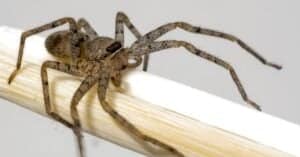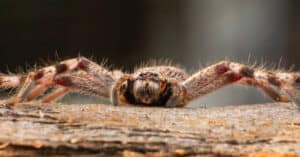France is home to a wide variety of spider species. Many of these are harmless and play an essential part in ecological equilibrium. Although predominantly not dangerous to humans, their appearance and defensive actions make encounters with them scary.
Unfortunately, there are a few species that are deadly to humans. Do not worry, as you are unlikely to find these in many places you visit in France. However, it is good to know about the species so that you are alert when enjoying the serene landscapes of France. This article looks at nine spiders found in France that are considered frightening due to their unusual appearance, defensive habits, capacity to cause discomfort, and venom.

1. Brown Recluse Spider
We start our list with the brown recluse spider, one of France’s most dangerous and scary spiders. It is partially the reason why many people in the country are afraid of spiders. While it is not aggressive, its venom is particularly dangerous. It is also one of the two you should look for when visiting France.
The spider is also called the violin spider, brown fiddler, and fiddle back spider.
Identifying Characteristics
- Females and males are generally the same size and grow between 6 and 20 mm.
- They are medium to light brown, but some may be blackish-gray to whitish.
- Some types have different colors for the upper body and abdomen.
- They have a black line on the underside that runs from their cephalothorax.
- It has long legs and sits with all its legs extended.
- The defensive position involves withdrawing the front legs.
Other Characteristics
The recluse spider is shy and likes to live in dark, hidden corners where predators cannot find it. It will run away from people given a chance. You will rarely see the spider in large numbers or around where you live.
Unfortunately, the spider has necrotic venom. The venom may cause the tissue around the bite area to die. The initial bite is not entirely painful. However, if the victim does not get quick medical attention, they are likely to feel excruciating pain as large areas of their bodies become infected and tissue decays.
The treatment for the condition is surgically removing the dead tissue, which leaves some scarring. In the worst cases, you can have the limb amputated. Stay calm, as bites are rare. It only bites in self-defense when accidentally pressed. Make it a habit of shaking your clothes and linens before using them as a preventive action.
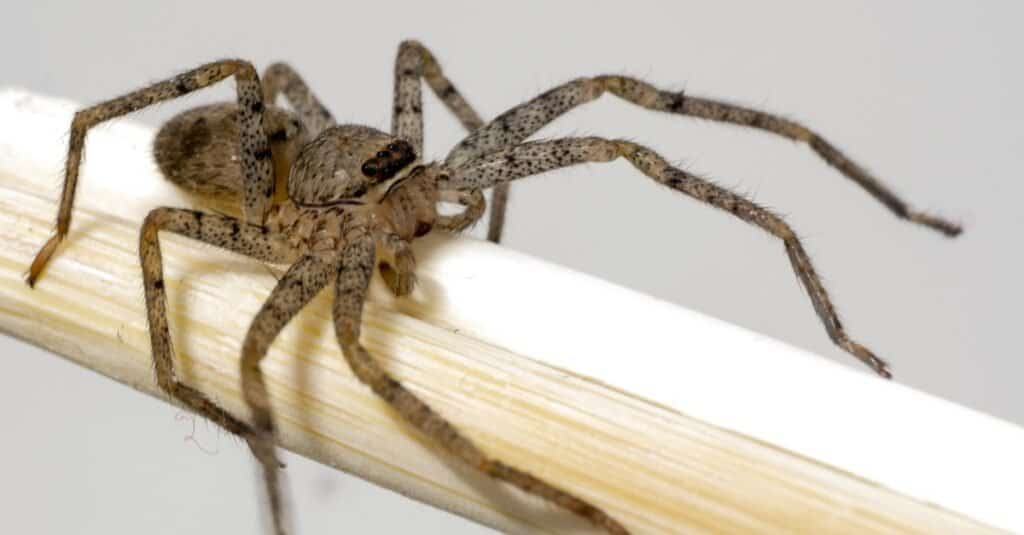
The spider’s venom is necrotic and can result in tissue death around the bite area.
©Physics_joe/Shutterstock.com
2. Black Widow Spider
This spider has gained notoriety around the globe as people fear it greatly. The French black widow spider is slightly different from that of North and South America. It has similar body characteristics, but its venom is somewhat less potent. This specific variety is called Mediterranean or European black widow.
Identifying Characteristics
- It is black, like the southern black widow. However, it has 13 spots located in the dorsal abdomen.
- These spots are usually red. You may also find them in other colors, such as yellow and orange.
- Females grow to between 7 and 15 mm.
- Males are slightly smaller at 4 to 7 mm.
- The female is the only one with a nasty bite. A male’s bite does not go past the skin’s epidermis.
- The body lacks the signature hourglass shape of North and South American species.
Other Characteristics
The venom of the Mediterranean widow is less potent than that of the recluse spider. However, it still causes swelling, spasms, pain in the area of the bite, abdominal pain, and breathing problems. It is rarely deadly to healthy human beings. However, if the victim has an underlying condition, it will likely be a concern. You should seek immediate medical attention.
This spider loves living in the warm grasslands and wheat fields across France. You will rarely find it in homes. In farming areas, it hides under unused machinery. Be careful when moving around in such areas.
The Mediterranean black widow rarely bites. When it does, it is because somebody touched or disturbed the web, and it reacted in self-defense — wearing gloves when harvesting can prevent these bites when working in the fields.
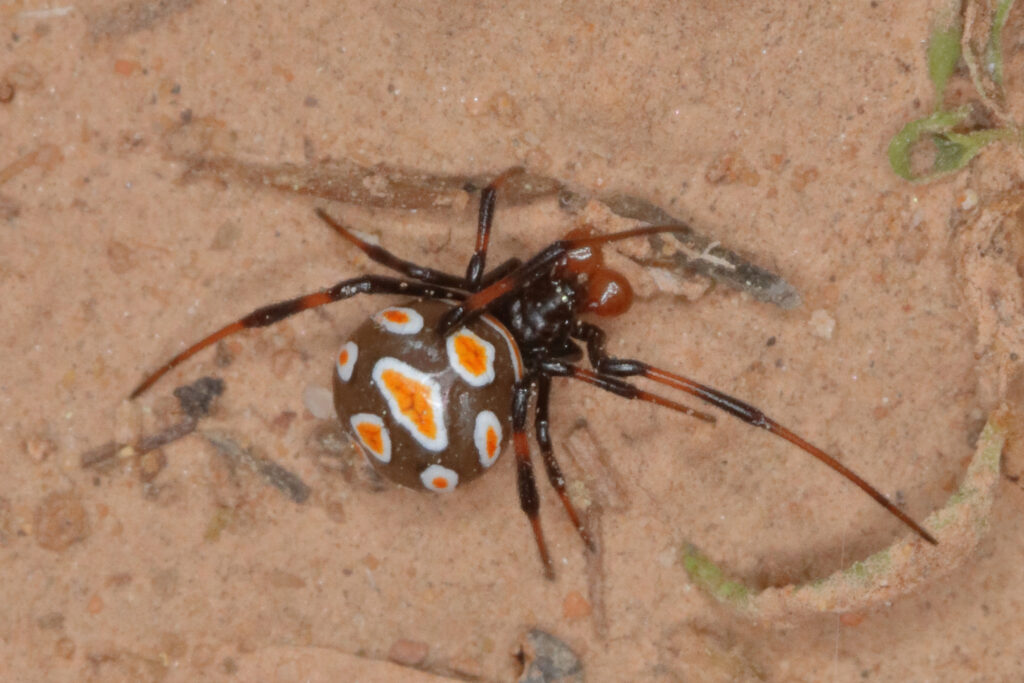
The Mediterranean black widow’s venom can cause symptoms such as swelling, pain, spasms, and breathing difficulties.
©iStock.com/Frank Buchter
3. False Widow Spider
The above two species are the only venomous spiders in France. The rest will not cause you any harm. However, the false black widow strikes fear when spotted. It bears the name due to its resemblance to the black widow. However, it does not have potent venom like the former.
Identifying Characteristics
- It is around a similar size to the black widow, with females from about 9.5 to 14 mm and males are 7 to 11 mm. It shares the same body shape as the black widow.
- The legs and bodies are shiny black, and the marks are similar to those of the black widow.
- The markings on the body are in the form of patterns, a single spot, or bands.
These distinctions are only helpful when reading — do not get too close to any of them. However, if you are bitten, you may want to trap the spider to help the health services differentiate it from the venomous type.
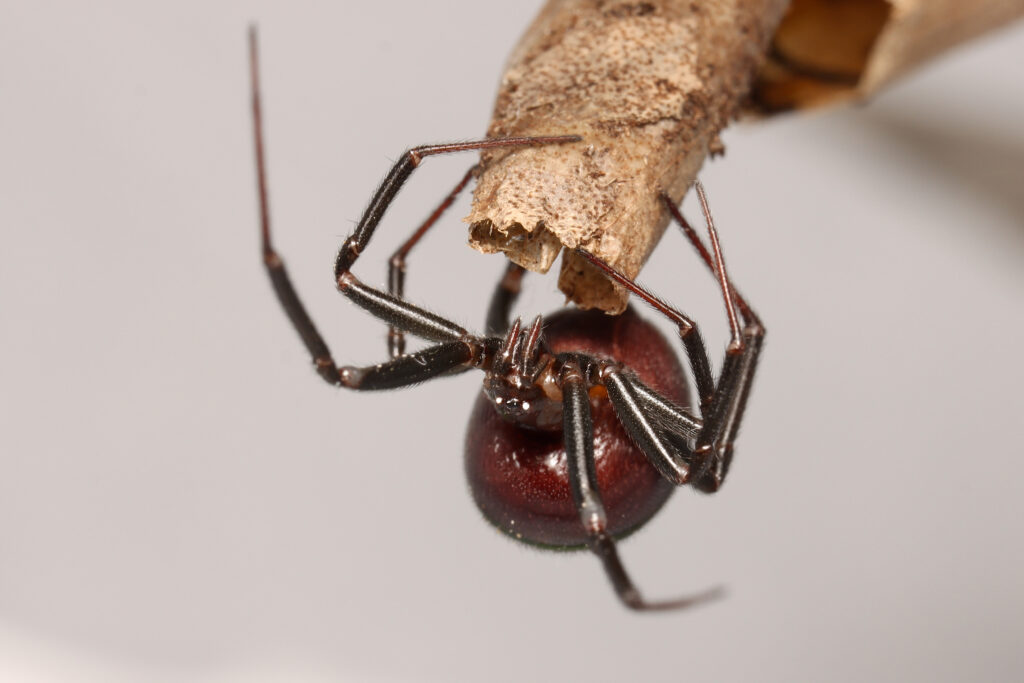
The false widow spider is named after the black widow due to its similar appearance, but it is not as venomous.
©Dan Olsen/Shutterstock.com
4. Tarantula Wolf Spider
It is time for the terrifying spiders in France! Fortunately, they are less harmful than any we have discussed so far. The tarantula wolf spider is the largest in all of Europe.
Identifying Characteristics
- Its body grows to a whopping 1.18 inches (30 mm).
- It has thick long legs that can grow up to 3 inches.
- Males are slightly smaller at about 19 mm.
- The female spider carries a silken sac with more than 100 eggs attached to its spinnerets.
- When the eggs hatch, the spiderlings climb the mother’s abdomen and ride on it.
Other Characteristics
These spiders love to burrow in the soil for protection. They are nocturnal species that hunt at night. However, sometimes males wander around in the daytime looking for mates.
These spiders live considerably longer than the conventional species. The males live for about two years, while the females live for about four. Interestingly, females cannibalize males after their sexual encounters.
The tarantula has excellent eyesight and speed, which help it stay away from danger. Therefore, you are less likely to come across one or provoke one for them to bite you.
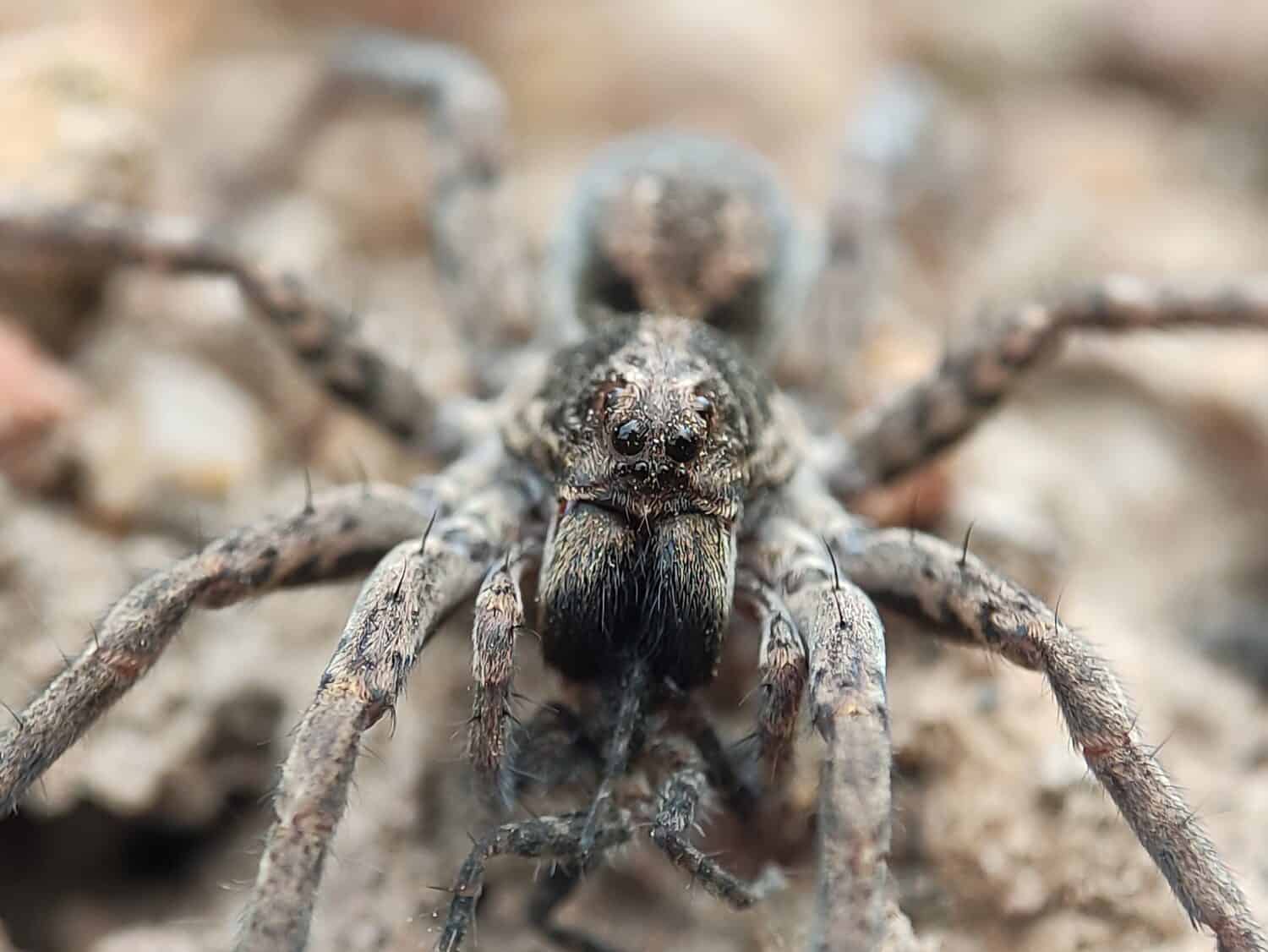
Tarantula wolf spiders have an extended lifespan compared to typical species, with females living up to four years.
©Stockalan/Shutterstock.com
5. Giant House Spider
The giant house spider is one of the most popular spiders in the world. You will find it across the globe. The French species is not different from others. You are likely to encounter this one at home or in hotel accommodations.
Despite the name, the spider is not a giant and does not have venom. It also does not come close to human beings. The abundance of insects near and around homes attracts them to living areas.
Identifying Characteristics
- The spider has a petite body that rarely grows more than 0.7 inches long. However, the legs reach a whopping 3 inches.
- Males have smaller bodies that grow to about 0.47 inches.
- The body and legs are usually dark brown. The sternum may have a lighter marking and has three spots that look like arrows on each side of the body.
Other Characteristics
This species creates funnel-shaped webs, hoping to attract unsuspecting insects, in forests, caves, and outhouses. In homes, they build webs in room corners, cellars, and storage rooms where they are less likely to be disturbed.
Its long legs help it latch on to the prey or run away from danger as it comes. It is not dangerous to humans and will run away at the slightest provocation. It is also said to chase away other species, such as the hobo spider.
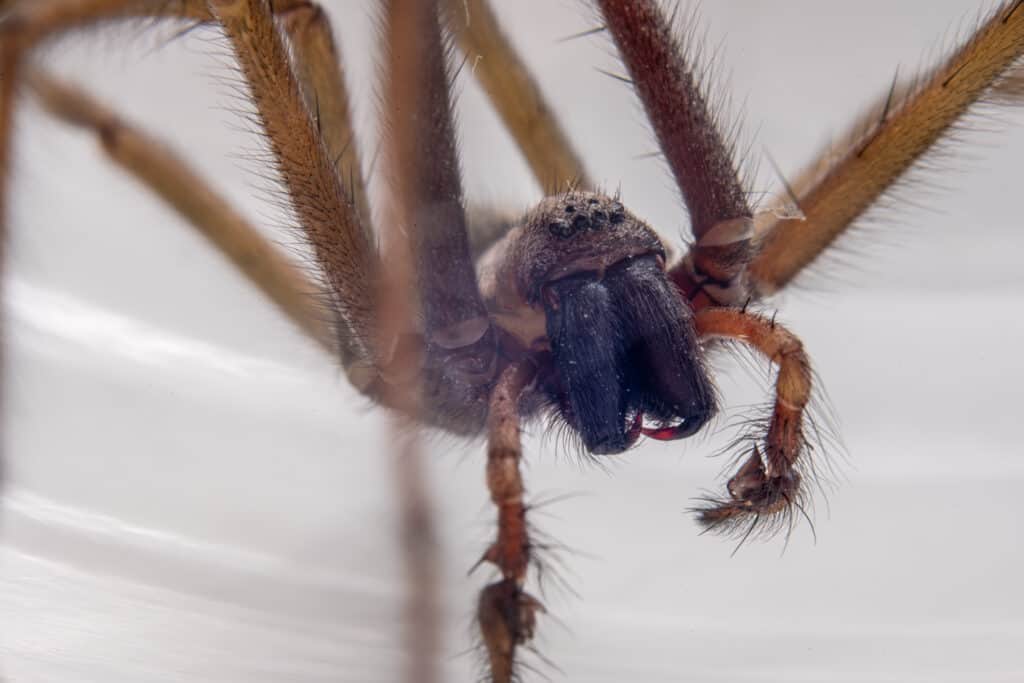
With its long legs, the giant house spider can quickly grab onto prey or escape from threats.
©iStock.com/Trygve Finkelsen
6. European Nursery Web Spider
The European nursery web spider is similar to a wolf spider. It gets its name from how the females protect the eggs until they are hatched. They start by holding the egg sacs by the mouth. Then they hide the sac under a leaf. Here, they spin a protective silk to enclose the egg.
Identifying Characteristics
- The spider has a slender, elongated abdomen and very long legs. It has the third longest legs among the European species.
- Its color ranges from reddish brown to light brown. Some are either gray or black. The reddish-brown species has a light stripe that moves down the middle of its back.
- Females are more prominent at 12 to 15 mm. Males are smaller with 10 to 13 mm.
Other Characteristics
The European nursery spider likes hiding among shrubs, tall grass, and at the edges of woodlands. However, it does not hide in the thicket, as it enjoys hunting during the daytime. The species also has a fascinating mating ritual.
Before mating, the male finds a dead insect as a gift for the female. If the female bites the gift, the male knows that it is interested in mating with it. It also keeps a leg in case the female changes her mind. The leg becomes a new way to show love and cause the female to calm down.
This spider species is not dangerous to humans. It would rarely bite and run away from any contact with larger animals. However, it may bite if provoked. Therefore, it is good to keep your distance wherever possible. They are not venomous, but you may swell or feel some stinging at the point of the bite.
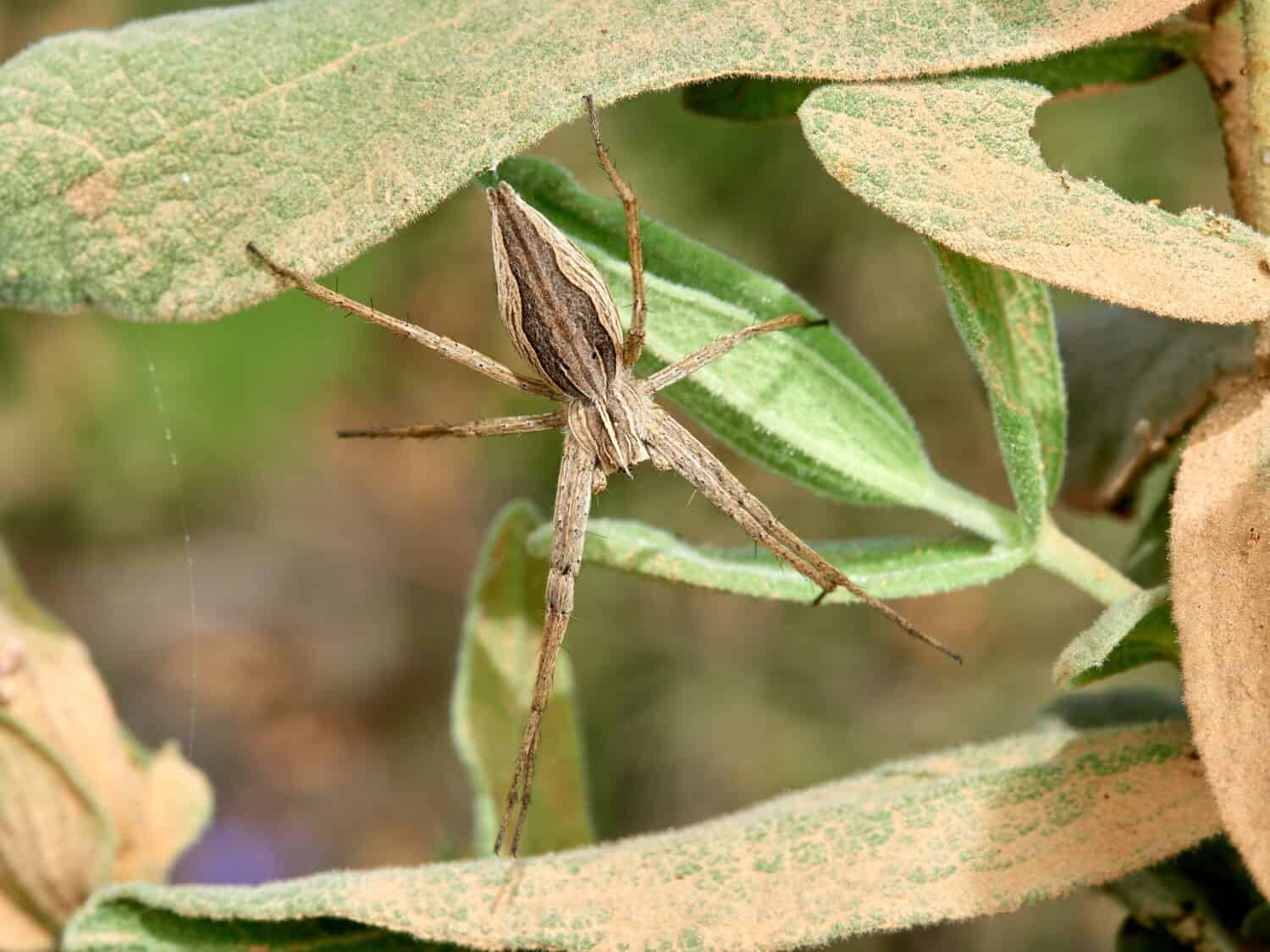
Before mating, the male European nursery web spider offers a dead insect as a gift to the female.
©Macronatura.es/Shutterstock.com
7. Long-Bodied Cellar Spider
The long-bodied cellar spider is in every basement corner. This spider is the most common species in homes, as they love warm habitats. It originates in subtropical climates across Asia.
Identifying Characteristics
- The legs are very thin and delicate and about six times the size of the body.
- The female bodies are about 8mm. Males are about 6 mm.
- Their bodies are brown. However, the cephalothorax has a different shade from that of the abdomen.
Other Characteristics
The spider is the most harmless species discussed in this article. It does not bite and will always run away when provoked. It stays upside down at those corners with the delicate legs pressed together. Its webs are also small and extend over a maximum distance that is twice the size of its body.
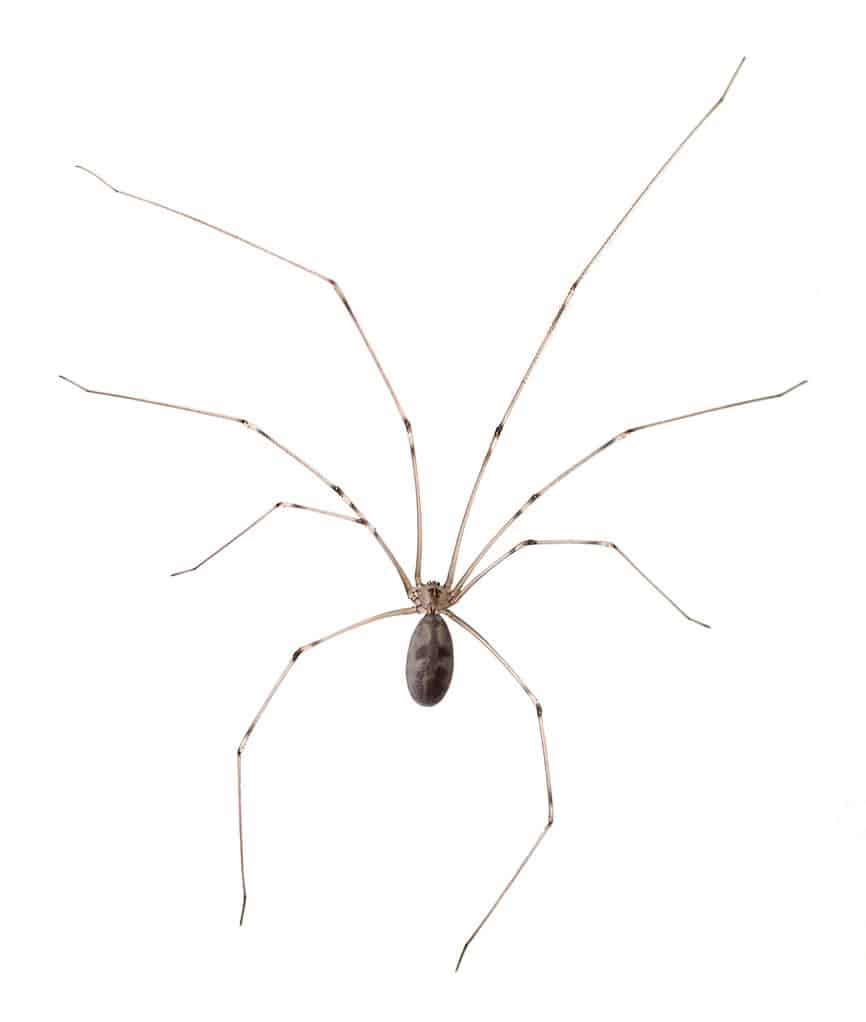
When provoked, the long-bodied cellar spider swiftly flees, often taking refuge in corners.
©Melinda Fawver/Shutterstock.com
8. Goldenrod Crab Spider
This is one of the scary spiders you will come across. It is also called a flower spider. The spider got its name from its ability to walk sideways, forward, and backward like crabs do. It is unique and has a peculiar behavior you do not usually see in other spiders.
Identifying Characteristics
- It has a flat but wide body.
- They are usually white or yellow. Some come in a combination of the two colors.
- There are others in pale green and pink, but these are a few.
- Females are twice the size of the males at 10 mm (males are just 5 mm).
Other Characteristics
These spiders can change their colors like chameleons according to the flower they are sitting on. This color-changing ability helps camouflage when hunting or evading predators. They hunt by switching between yellow and white colors based on the flower they are on. They do not spin a web but use silk to entrap their prey.
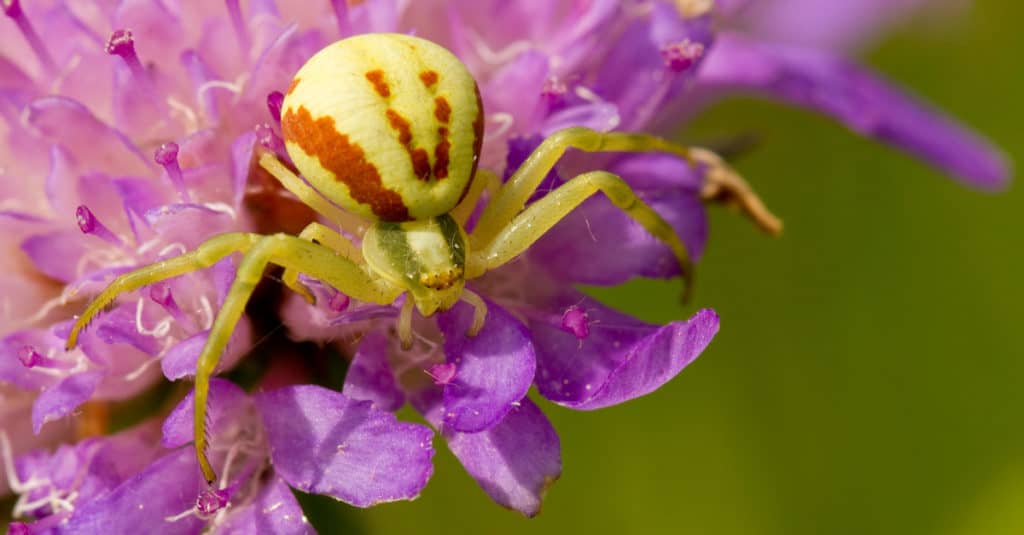
Goldenrod crab spiders’ color-changing abilities helps camouflage them when hunting or evading predators.
©Radka Palenikova/Shutterstock.com
9. Zebra Jumping Spider
Zebra jumping spiders love living in open, often vertical habitats. Therefore, you will likely find them in the rock faces and tree trunks. They also live close to people, on house walls and garden faces. You may also find one or two at the corners of your window sills.
Identifying Characteristics
- The spider looks like zebra with black and white stripes, hence the name.
- It has enormous median eyes, which give them an excellent vision.
- Female spiders are slightly larger at 6 to 9 mm. Males are slightly smaller at 5-6 mm.
Other Characteristics
Like jumping spiders, they do not build a web to capture prey. Instead, they use their good eyesight to hunt for invertebrates. These spiders also hunt for smaller ones. However, their hunting is a little different. Instead of rushing at the prey, they move slowly until they are close enough to it. They then jump to make a kill, like a cat.
They also use silk to help them reach their prey. However, they do not make a web but attach a thread and slide down to the prey. Like many other spiders discussed here, they are not dangerous to humans. They do not bite unless threatened. When they do, the bite is not harmful and does not require medical attention.
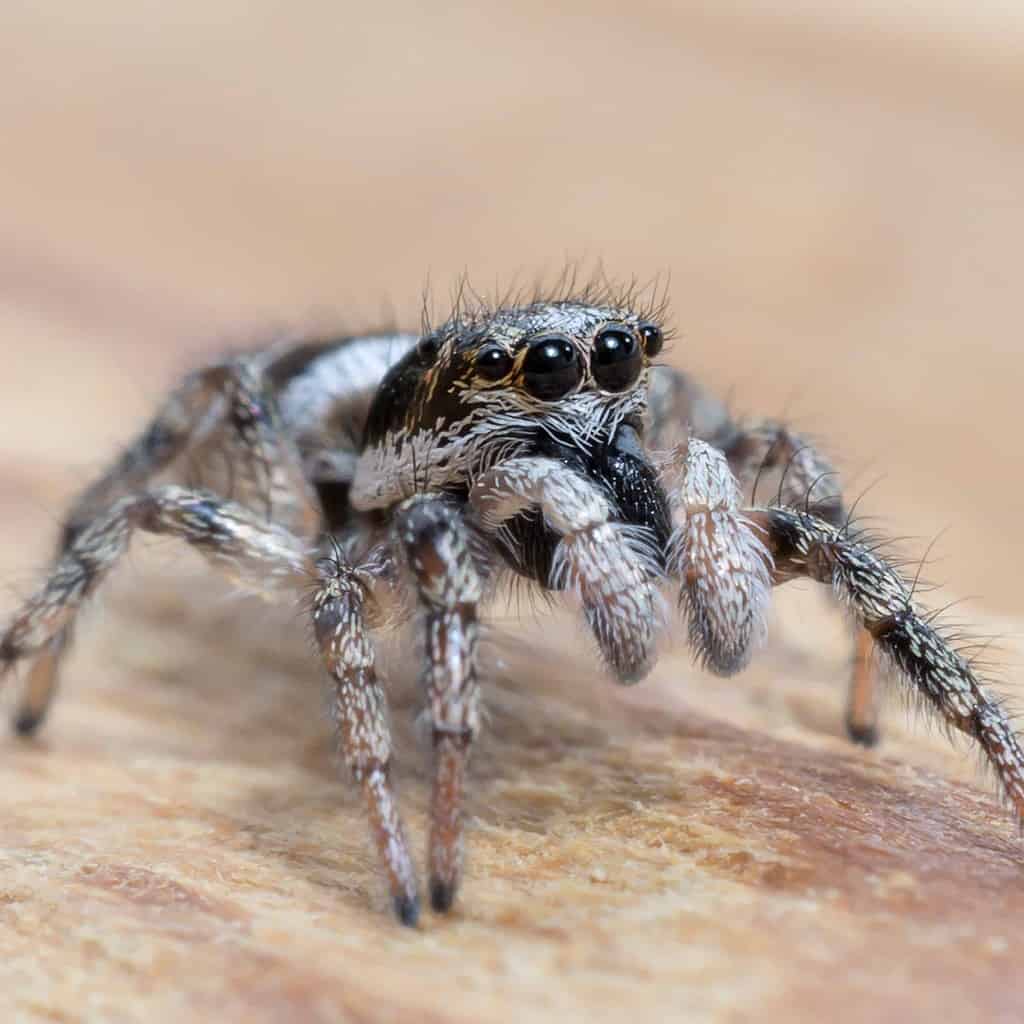
The zebra jumping spider do not build a web to capture prey, but use their good eyesight to hunt.
©Photographer: Rabanser/Shutterstock.com
Summary of 9 Scary Spiders Found in France
Here’s a recap of the nine spider species found in France that are considered frightening.
| Number | Spider | Type | Size |
|---|---|---|---|
| 1 | Brown Recluse Spider | Venomous | 6-20 mm |
| 2 | Black Widow Spider | Venomous | Females: 7-15 mm; males: 4-7 mm |
| 3 | False Widow Spider | Nonvenomous | Females: 9.5-14 mm; males: 7-11 mm |
| 4 | Tarantula Wolf Spider | Nonvenomous | Females: 30 mm; males: 19 mm |
| 5 | Giant House Spider | Nonvenomous | Females: body size is 18 mm, legs reach 76 mm; males: body size is 12 mm |
| 6 | European Nursery Web Spider | Nonvenomous | Females: 12-15 mm; males: 10-13 mm |
| 7 | Long-Bodied Cellar Spider | Nonvenomous | Females: body size is 8 mm; males: body size is 6 mm |
| 8 | Goldenrod Crab Spider | Nonvenomous | Females: 10 mm; males: 5 mm |
| 9 | Zebra Jumping Spider | Nonvenomous | Females: 6-9 mm; males: 5-6 mm |
Scary Arachnids Are a Part of France’s Beauty
As you enjoy the greenery in the vine-growing valleys of France, know something else lurks in the deep; scary spiders. However, among the 1,000-plus species, only two are dangerous to humans. Please take notice of them, as they are the only ones that pose a danger to you in this beautiful land.
The rest of the species are not harmful, although they may bite when provoked. Therefore, avoid getting in their way or poking them with your fingers. Also, get help if you get a spider bite. A good number are also beautiful. Many of them are, however nocturnal, meaning you might never find them in the dark. We should appreciate the role these creatures play in maintaining ecological balance. They contribute to the delicate balance by controlling insect populations and serving as important prey for other animals. By understanding these creatures, we can learn to coexist with them and appreciate the beauty and diversity they bring to our world.
The photo featured at the top of this post is © Tobias Hauke/Shutterstock.com
Thank you for reading! Have some feedback for us? Contact the AZ Animals editorial team.





